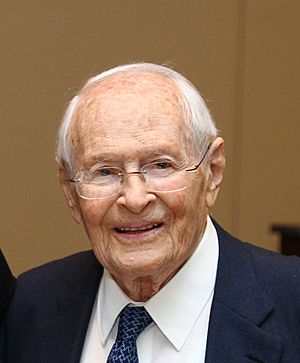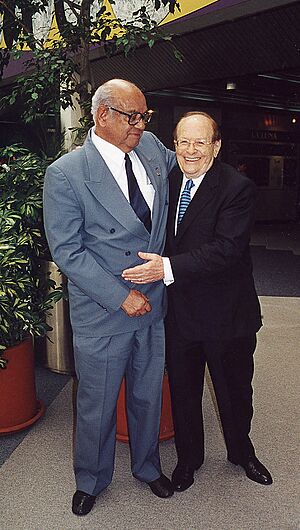George Rosenkranz facts for kids
Quick facts for kids
George Rosenkranz
|
|
|---|---|

George Rosenkranz receiving the Biotechnology Heritage Award in Chicago, 2013
|
|
| Born | 20 August 1916 Budapest, Hungary
|
| Died | 23 June 2019 (aged 102) Atherton, California, U.S.
|
| Nationality | Mexican |
| Scientific career | |
| Fields | Chemistry |
George Rosenkranz (born György Rosenkranz; 20 August 1916 – 23 June 2019) was a very important Mexican scientist. He was a pioneer in steroid chemistry. This means he studied special chemicals called steroids. He used plants from Mexico to make these chemicals.
George Rosenkranz was born in Hungary. He studied in Switzerland. He moved to the Americas to escape the Nazis. He finally settled in Mexico.
At a company called Syntex in Mexico City, Rosenkranz built a team of amazing chemists. These included future leaders like Carl Djerassi, Luis E. Miramontes, and Alejandro Zaffaroni. Under Dr. Rosenkranz's guidance, they made huge steps in understanding and producing steroid medicines. Syntex created a special chemical called a progestin. This was used in many helpful steroids. Because of Rosenkranz, Syntex became a very strong international company. It was a leader in making steroid medicines. He retired as CEO in 1982 when he was 65.
In 2012, he received the Biotechnology Heritage Award. This award recognized his big contributions to biotechnology. He helped with discoveries, new ideas, and public understanding. He turned 100 years old in August 2016.
Rosenkranz also loved playing duplicate bridge. This is a card game. He was a Grand Life Master in the American Contract Bridge League. He won many national titles. He also wrote or helped write more than 10 books about bridge.
Contents
George Rosenkranz: A Life in Science
George Rosenkranz was born in 1916 in Budapest, Hungary. His parents were Etel and Bertalan Rosenkranz. He studied chemical engineering at the Swiss Federal Institute of Technology. There, he earned his doctorate degree. His teacher, Lavoslav Ružička, who later won a Nobel Prize, got Rosenkranz interested in steroid research.
Escaping Danger and Finding a New Home
At that time, Nazi supporters were active in Zurich. Ružička protected Rosenkranz and other Jewish friends. But their presence put their teacher at risk. Rosenkranz said in 2002, "We decided to leave Switzerland to protect him."
Ružička helped Rosenkranz get a job in Quito, Ecuador. While Rosenkranz was waiting in Havana, Cuba, for a ship, Japan attacked Pearl Harbor. The United States entered World War II. Rosenkranz could not go to Ecuador. So, he accepted an offer from the Cuban president, Fulgencio Batista. This allowed refugees to stay and work in Cuba. He found work at the Vieta Plasencia Lab.
Building a Scientific Powerhouse in Mexico
Scientists already knew that hormones were important for human health. But they didn't know how to make them in a lab. George Rosenkranz's chemistry skills caught the eye of Emeric Somlo and Dr. Federico Lehmann. They had started a company called Syntex in Mexico City in 1944. They wanted to make the hormone progesterone. They planned to use Mexican yams that contained a chemical called diosgenin. This led to a big trade in Mexican yams.
A professor named Russell Marker, who worked with them, left after a disagreement. He took his steroid knowledge with him. Rosenkranz was hired to replace him. He moved to Mexico City in 1945.
Rosenkranz had a big challenge. He needed to figure out what was in Marker's samples. He also had to understand Marker's chemical processes. He didn't have much help. His first team had nine lab assistants and only one other chemist. Mexico also didn't have a PhD program in chemistry.
When he couldn't find enough trained chemists, Rosenkranz hired researchers from Mexico and other countries. Rosenkranz also helped create a chemistry institute. This was the Instituto de Química at the Universidad Nacional Autónoma de México. It is now a leading center for plant research in Mexico. He brought in great chemists as researchers and teachers. He also got money to expand programs for training chemists. He and his colleagues often worked at Syntex during the day. Then, they spent evenings teaching chemistry. Rosenkranz also helped start the Institute for Molecular Biology in Palo Alto.
Breakthroughs in Medicine
Attracting young chemists like Carl Djerassi, Luis E. Miramontes, and Alejandro Zaffaroni was key to Syntex's first big success. Miramontes, George Rosenkranz, and Djerassi worked together. They created a chemical called norethindrone. This was later shown to prevent pregnancy. This discovery brought a lot of money to Syntex. It also boosted the Mexican steroid medicine industry.
The Mayo Clinic had reported that the steroid hormone cortisone helped with pain from rheumatoid arthritis. But it was very hard to get. As Djerassi explained, "Until 1951, the only source of cortisone was through an extraordinarily complex process of 36 different chemical transformations starting from animal bile acids." Many top scientists around the world were trying to be the first to make cortisone. Rosenkranz's team worked in two shifts. Their hard work paid off. In 1951, Rosenkranz, Djerassi, and their team published a paper on making cortisone. They beat reports from Harvard and Merck by just a few weeks.
After successfully making cortisone, the Syntex researchers kept working. They focused on making progesterone. Progesterone is a female sex hormone. It was used to help pregnant women avoid miscarriages. It also helped treat infertility. Five months later, under Rosenkranz and Djerassi's guidance, Miramontes finished making norethisterone (norethindrone). Syntex applied for a patent for it. This patent was granted on May 1, 1956. Syntex first worked with an American company, Parke-Davis. They marketed norethisterone as Norlutin for women's health issues. The FDA approved it in 1957.
Rosenkranz knew that scientists needed to be recognized by their peers. This was as important as making money. He said, "To have people work productively, you have to build an intellectually challenging environment, allow creative freedom, and insure peer recognition and respect for the individual." Many scientific papers about steroid chemistry came from Rosenkranz's lab in the 1940s and 1950s. Rosenkranz himself wrote or co-wrote over 300 articles. He is named on over 150 patents.
Rosenkranz left his leadership roles at Syntex in 1981. Even though he was officially retired for over thirty years, he stayed active in the industry. In 1996, he joined the board of Digital Gene Technologies. He was also president of the advisory board of ICT Mexicana. He passed away on June 23, 2019, at the age of 102.
Scientific Groups and Awards
- National Academy of Medicine of Mexico
- New York Academy of Science
- University of Tel Aviv boardmember
- Weizmann Institute of Science in Rehovot, Israel, board member
- 2013 Biotechnology Heritage Award
- 2004 Winthrop-Sears Medal
- 2001 Condecoracion Eduardo Liceaga (Mexico's highest health award)
- 1994 Dr. Leopoldo Rio de la Loza (Mexican National Prize in Pharmaceutical Sciences)
- Leadership Award of the Mexican Health Federation
George Rosenkranz: Bridge Master
Rosenkranz was a world-class bridge player. He was one of the most successful players from Mexico. He won 12 major events at the North American Bridge Championships. These included all four big team titles. He played for Mexico in the World Team Olympiad three times. He also played for the United States in the 1983 Bermuda Bowl.
He also made important contributions to how bridge is played. He created a bidding system called Romex. This system added many new ideas to the standard way of bidding. He also invented the Rosenkranz double and Rosenkranz redouble. He wrote more than a dozen books about bridge.
Bridge Awards
- ACBL Hall of Fame, Blackwood Award 2000
- ACBL Honorary Member 1990
- Precision Award 1976
Tournament Wins
- North American Bridge Championships (12 wins)
- Master Mixed Teams (1) 1990
- Open Swiss Teams (1) 1991
- North American Swiss Teams (1) 1990
- Grand National Open Teams (1) 1981
- Men's Board-a-Match Teams (2) 1984, 1987
- Reisinger Board-a-Match Teams (1) 1985
- Spingold Knockout Teams (2) 1976, 1984
- Vanderbilt Knockout Teams (3) 1975, 1976, 1982
Tournament Runner-Up Finishes
- North American Bridge Championships (15 times)
- Blue Ribbon Pairs (1) 1974
- Silver Ribbon Pairs (1) 1992
- Master Mixed Teams (3) 1967, 1984, 1994
- Open Swiss Teams (2) 1998, 2003
- Men's Board-a-Match Teams (1) 1975
- Open Board-a-Match Teams (2) 1990, 2000
- Spingold Knockout Teams (1) 1967
- Vanderbilt Knockout Teams (2) 1978, 2001
- Reisinger Board-a-Match Teams (2) 1980, 1997
- Other notable 2nd places:
- United States Bridge Federation Bermuda Bowl qualifiers (1) 1982
Books by George Rosenkranz
Bridge Books
- The Romex System of Bidding: a dynamic approach to bridge (1970)
- Win with Romex: the key to accurate bidding (1975)
- Bid Your Way to the Top (1978)
- Bridge, the Bidder's Game (1985)
- Slam Bidding (1985)
- Everything You Always Wanted to Know About Trump Leads and Were Not Afraid to Ask (1986)
- Tips for Tops (1988)
- More Tips for Tops (1991)
- Our Man Godfrey: tales from the bridge table (1994), edited by Phillip Alder
Bridge Books with Co-Authors
- Modern Ideas in Bidding (1982), with Alan Truscott
- Bid to Win, Play for Pleasure (1990), with Alder
- Bidding on Target (1992), with Truscott and Alder
- Godfrey's Bridge Challenge (1996), with Alder
- Godfrey's Stairway To The Stars: a step-by-step guide to modern bidding (1998), with Alder
- Godfrey's Angels (2001), with Alder
The four Godfrey books mix fictional stories with bridge lessons. Godfrey's Bridge Challenge explains the Romex system through fun stories and quizzes. Godfrey's Angels includes updates to the system from 1998 to 2001.
Memoir
- George and Edith Rosenkranz: a memoir of their lives and times (2011), with editor Arnold Thackray
See also
 In Spanish: George Rosenkranz para niños
In Spanish: George Rosenkranz para niños



